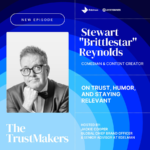By Zoe Zelken, Strategist, Imagination
The digital age, while offering unparalleled connectivity, has paradoxically fostered a sense of isolation among young people. Gen Z, in particular, is navigating a world saturated with fleeting online interactions, leading to a yearning for genuine community along with the desire to feel part of tangible experiences. This hunger for real life connections has fueled a powerful wave of nostalgia.
Gen Z – The most nostalgic generation?
Gen Z might just be the most nostalgic generation we have seen, according to a report from GWI. Studies show that, rather than looking forward, this generation prefers to look back. Could they be longing for simpler times? In culture, they are leading the resurgence of retro fashion, analog technologies, and simple communal activities. Beyond mere aesthetic preferences, this nostalgia reflects a deeper desire for authentic experiences. Gen Z is seeking community, not just online followers. They crave shared moments, real-life interactions, and a sense of belonging to something larger than themselves. This desire for genuine connection is why brands that prioritize IRL experiences are resonating so strongly.
Experiences to build community
Brands can capitalize on this trend by creating immersive, experiential events that foster a sense of community. Pop-up shops that offer hands-on workshops, interactive installations, and opportunities for social interaction can transform a transactional relationship into a meaningful connection – so securing long-term positive memories. For example, the Mets recently launched a pop-up store, known as Mets House, to build awareness for the baseball opening season. Through one-of-a-kind merchandise experiences and enthralling activities, Mets House immersed fans in the Mets’ world beyond the ballpark. The experience had a nostalgic aura to it because it relied on analog activities rather than high-tech ones. Mets House illustrates an important lesson for brands that want to engage Gen Z — showing up in their world with simple experiences is more than enough.
The 90s and 00s IP
Brands can use the power of nostalgia by aligning themselves with popular IPs from the 90s and the 00s — two of Gen Z’s favorite eras. Airbnb has been stellar in this respect. Its icons series creates experiential worlds and is often based on IPs with a nostalgic bend. It is no wonder that its Barbie Dreamhouse experience reached press highs.
Concentrate on the authentic and the simple
An important lesson when crafting nostalgic experiences is that they must feel, and be perceived, as authentic. Gen Z is highly discerning and can quickly detect insincerity. Brands must avoid simply appropriating nostalgic aesthetics for marketing purposes. Instead, they should strive to create genuine experiences that reflect the values and aspirations of their target audience and the experiences should provide Gen Z with a much needed respite from the stress of daily life. This means prioritizing community building, fostering genuine interactions, and creating spaces where young people feel seen and heard.
The focus on intentional simplicity is also a key factor. Gen Z is overwhelmed by the constant barrage of information and digital stimulation. Young people are seeking experiences that are meaningful, mindful, and grounded in reality. It is why activities like hiking, camping, and other outdoor pursuits are gaining popularity. Brands can tap into this desire for simplicity by offering products and experiences that promote mindfulness, sustainability, and a connection with nature.
Brands have a significant opportunity to build lasting relationships with young people by understanding and responding to their desire for community and nostalgia. By creating authentic, immersive experiences that foster genuine connection and promote intentional simplicity through analog activities, brands can become more than just purveyors of products and services. They can become integral parts of the communities they serve.











